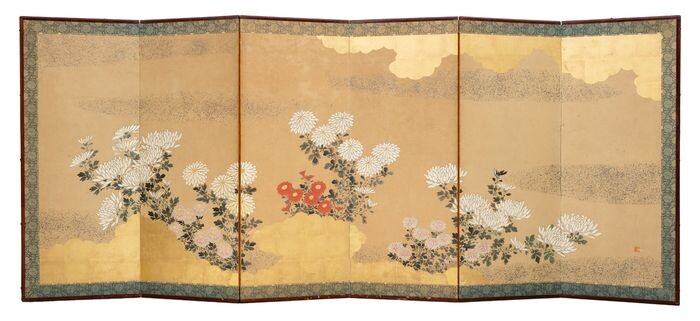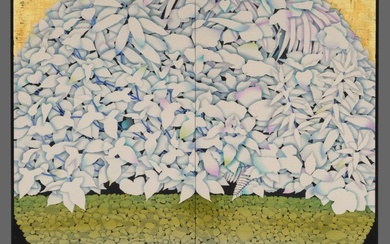Byobu, Folding screen - Lacquer, Paper, Wood, Gold leaf - Flowers - Wonderful medium-size 6-panel room divider with a Rinpa-style painting of chrysanthemum flowers. - Japan - Meiji period (1868-1912) - Late 19th century
A very alluring medium-sized six-panel byôbu 屏風 (room divider) with a refined continuous Rinpa-style painting of many different types of chrysanthemums 菊 (kiku) . Several clutches with a great variety of chrysanthemum flowers are in full bloom and they each show their unique form and colour. Varying from, white, red and soft pink. A serene space surrounds the flower, accentuated by silver speckled clouds and dense golden clouds. The serene touch of the painting is reminiscent of the style of the Rinpa-school. This multi-coloured painting is set on paper background, and the chrysanthemum flowers are painted by using shell paste 胡粉 (gofun) in low relief. In the lower right corner it bears an ornamental seal reading the auspicious Chinese saying 'Birds' twitter and fragrance of flowers'. The panels are surrounded by two silk borders, a thin light one with a black karakusa-motive, and a wide green one with a flower motive. The screen is protected by a dark red lacquer wooden frame. Considering the age, which is approximately 120-140 years old, the byôbu is in a good condition. There are only some signs of age, wear and old restorations. Please see the photos for reference. This room divider is very light in weight and can also be easily mounted flat on a wall and presented as one piece of art. Total width: 294. 2 cm (2 x 50. 1 cm and 4 x 48. 5 cm) ; Height: 124. 4 cm. The Rinpa School was a key part of the Edo period revival of indigenous Japanese artistic interests described by the term yamato-e. Paintings, textiles, ceramics, and lacquerwares were decorated by Rinpa artists with vibrant colours applied in a highly decorative and patterned manner. Favoured themes, which often contained evocative references to nature and the seasons, were drawn from Japanese literature, notably The Tale of Genji, The Tales of Ise, and Heian-period poems composed by courtiers. (From the MET museum) . When shipped we will add a certificate of authenticity.
[ translate ]View it on
Estimate
Time, Location
Auction House
A very alluring medium-sized six-panel byôbu 屏風 (room divider) with a refined continuous Rinpa-style painting of many different types of chrysanthemums 菊 (kiku) . Several clutches with a great variety of chrysanthemum flowers are in full bloom and they each show their unique form and colour. Varying from, white, red and soft pink. A serene space surrounds the flower, accentuated by silver speckled clouds and dense golden clouds. The serene touch of the painting is reminiscent of the style of the Rinpa-school. This multi-coloured painting is set on paper background, and the chrysanthemum flowers are painted by using shell paste 胡粉 (gofun) in low relief. In the lower right corner it bears an ornamental seal reading the auspicious Chinese saying 'Birds' twitter and fragrance of flowers'. The panels are surrounded by two silk borders, a thin light one with a black karakusa-motive, and a wide green one with a flower motive. The screen is protected by a dark red lacquer wooden frame. Considering the age, which is approximately 120-140 years old, the byôbu is in a good condition. There are only some signs of age, wear and old restorations. Please see the photos for reference. This room divider is very light in weight and can also be easily mounted flat on a wall and presented as one piece of art. Total width: 294. 2 cm (2 x 50. 1 cm and 4 x 48. 5 cm) ; Height: 124. 4 cm. The Rinpa School was a key part of the Edo period revival of indigenous Japanese artistic interests described by the term yamato-e. Paintings, textiles, ceramics, and lacquerwares were decorated by Rinpa artists with vibrant colours applied in a highly decorative and patterned manner. Favoured themes, which often contained evocative references to nature and the seasons, were drawn from Japanese literature, notably The Tale of Genji, The Tales of Ise, and Heian-period poems composed by courtiers. (From the MET museum) . When shipped we will add a certificate of authenticity.
[ translate ]



